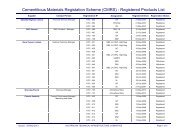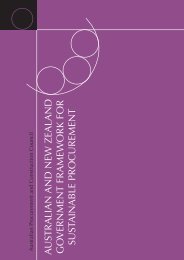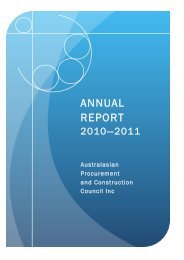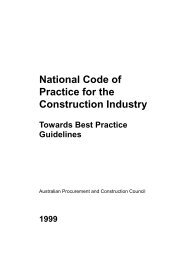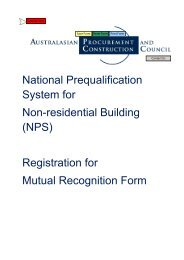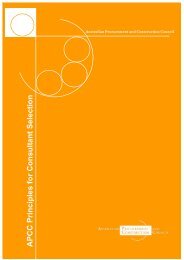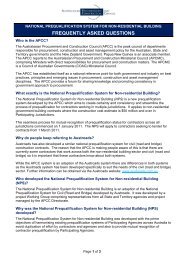Assessing a Supplier's Sustainability Credentials - Australian ...
Assessing a Supplier's Sustainability Credentials - Australian ...
Assessing a Supplier's Sustainability Credentials - Australian ...
Create successful ePaper yourself
Turn your PDF publications into a flip-book with our unique Google optimized e-Paper software.
ASSESSING A SUPPLIER’S SUSTAINABILITY<br />
CREDENTIALS
ABOUT THE AUSTRALIAN PROCUREMENT AND CONSTRUCTION<br />
COUNCIL<br />
Founded in 1967 the <strong>Australian</strong> Procurement and Construction Council Inc (APCC) (formerly<br />
the National Public Works Council) is the peak council of departments responsible for<br />
procurement, construction and asset management policy for the <strong>Australian</strong>, State and<br />
Territory governments and the New Zealand Government. The APCC reports to the<br />
<strong>Australian</strong> Procurement and Construction Ministerial Council (APCMC), comprising Ministers<br />
with direct responsibilities for procurement and construction matters. The APCMC is a<br />
Council of <strong>Australian</strong> Governments (COAG) Ministerial Council.<br />
The APCC has established itself as a national reference point for both government and<br />
industry on best practices, principles and emerging issues in procurement, construction and<br />
asset management disciplines.<br />
The APCC collective maximises opportunities to leverage off one another and provides<br />
leadership in these disciplines to improve and implement new and evolving procurement<br />
practices in ways that will deliver service benefits to the <strong>Australian</strong> and New Zealand<br />
communities.<br />
The APCC forum is a catalyst for knowledge sharing, intelligence gathering and has the<br />
information networks to draw on for innovative business solutions for jurisdictions to deliver<br />
expected targets, savings and outcomes. The APCC collective continues to strengthen<br />
relationships with government partners and other stakeholders to promote a consistent and<br />
coordinated national approach to government procurement.<br />
ABOUT SUSTAINABLE PROCUREMENT<br />
Sustainable procurement means that when buying goods and services organisations will<br />
consider:<br />
• strategies to avoid unnecessary consumption and manage demand<br />
• minimising environmental impacts of the goods and services over the whole-of-life of<br />
the goods and services<br />
• suppliers‟ socially responsible practices including compliance with legislative<br />
obligations to employees<br />
• value for money over the whole-of-life of the goods and services, rather than just<br />
initial cost.<br />
CONTACT US<br />
Email:<br />
info@apcc.gov.au<br />
Phone: (02) 6285 2255<br />
Web:<br />
www.apcc.gov.au<br />
The work contained within this Guide is copyright.<br />
This Guide may not be, in part or whole, reproduced without prior permission from the<br />
<strong>Australian</strong> Procurement and Construction Council Inc.<br />
2
ASSESSING A SUPPLIER’S SUSTAINABILITY CREDENTIALS<br />
This <strong>Australian</strong> Procurement and Construction Council (APCC) sponsored project is<br />
part of the implementation of the <strong>Australian</strong> and New Zealand Government Framework<br />
for Sustainable Procurement (Framework). The Framework was released by the<br />
<strong>Australian</strong> Procurement and Construction Ministerial Council in September 2007.<br />
This document aims to provide a useful set of sustainability related supplier questions<br />
to procurement officers involved in developing tender or request documents or when<br />
assessing the sustainability credentials of a contracted supplier.<br />
Procurement Officers across all levels of government are increasingly required to include<br />
sustainability considerations in their decision making. The criteria or questions that follow<br />
are designed to provide guidance on how an officer might assess the level of commitment<br />
and performance of a contracted supplier (or respondent to a tender) to environmental and<br />
social sustainability.<br />
Particular criteria or questions may not be applicable to some goods or services, nor to some<br />
suppliers or contract types. The intention is that officers select those criteria or questions<br />
most appropriate for their procurement or contract management requirements. Alternatively<br />
some or all of these questions could be used as a supplier questionnaire as part of the<br />
tender process.<br />
Potential questions have been grouped into the following categories of sustainability<br />
commitment and performance:<br />
• Systems for Environmental Management<br />
• Employment Practices<br />
• Corporate Social Responsibility<br />
• Greenhouse Gas Emissions<br />
• Commitment to sustainability and demonstrated sustainability improvements<br />
• Packaging<br />
• Transport and Logistics<br />
• „Green' Product Reporting<br />
Suggested Evaluation Criteria applicable to each category of questioning have also been<br />
included for guidance purposes only. These are typically arranged as a graduated level of<br />
performance or commitment in order to assist in making comparative assessments.<br />
Any supplier to government reading this document should note that these criteria may not be<br />
universally applied and that the suggested evaluation criteria and scoring may vary from one<br />
tender to the next. Also it is important to note that variations of this document will be<br />
progressively “rolled-out” by jurisdictions.<br />
3
No.<br />
Potential Supplier Questions<br />
1. Systems for Environmental Management<br />
Part A<br />
Describe the system, processes and practices that enable your organisation to<br />
reduce your environmental impacts, meet your legal environmental requirement and<br />
achieve continual improvement of your environmental performance?<br />
Criteria that are to be commented on in responding to this requirement include:<br />
The existence of an operational environmental management system (EMS).<br />
Please indicate whether this meets a recognised standard, such as ISO 14001,<br />
European EMAS, U.S. EPA Performance Track or equivalent. Please provide<br />
evidence of certification.<br />
The organisation‟s environmental policy, which commits the organisation to a<br />
programme of environmental improvement. Please provide a copy of the policy.<br />
The organisation‟s environmental strategy, objectives and targets, as well as key<br />
performance indicators for these targets. Please provide examples.<br />
How the environmental policy, strategy and targets are communicated to all staff,<br />
including any training provided on sustainability.<br />
Part B<br />
In the last two years has your organisation been subject to any court proceedings<br />
related to breaches of environmental legislation? If yes, what was the outcome?<br />
Part C<br />
Does your organisation maintain records of potential environmental hazards and<br />
have mitigation strategies and systems in place to reduce environmental hazards,<br />
e.g. carcinogens, irritants? Please provide examples.<br />
2. Employment Practices<br />
Part A<br />
What does your organisation do to apply fair employment practices to your workforce<br />
employees and sub contractors?<br />
Criteria to be commented on in responding to this requirement include:<br />
The organisation‟s documented policy for workforce and labour practices aligned<br />
to international standards, e.g. UN Global Compact International Labour<br />
Organisation Certification of employment practices to SA 8000.<br />
Requirements for your organisation‟s suppliers to have workplace practices<br />
based on ILO core conventions, certified to SA8000 or similar.<br />
Other certifications relevant to employment practices, eg Fairtrade certified.<br />
Please provide evidence of certification and provide details of the products<br />
certified.<br />
Part B<br />
Has your organisation had any employment related convictions in the past two<br />
years? If yes, what was the outcome?<br />
4
No.<br />
Potential Supplier Questions<br />
3. Corporate Social Responsibility (CSR)<br />
Describe the formalised programs or initiatives that the organisation has in place that<br />
are directed towards meeting social and ethical responsibilities and objectives.<br />
Criteria that are to be commented on in responding to this requirement include:<br />
Corporate Reporting that describes the organisation‟s approach to CSR, preferably<br />
with such reporting meeting external reporting guidelines, e.g. the Global Reporting<br />
Initiative‟s (GRI) <strong>Sustainability</strong> Reporting Guidelines (2002) and is publicly available.<br />
Any other formal CSR commitments made or CSR initiatives in which the<br />
organisation is involved.<br />
Awards or nominations that the organisation has received for its CSR activities.<br />
Please provide evidence.<br />
4. Greenhouse gas (GHG) emissions<br />
What steps does your organisation take to reduce its greenhouse gas emissions?<br />
Criteria to be commented on in responding to this requirement include:<br />
Initiatives that the organisation has undertaken to calculate its GHG emissions,<br />
indicating whether these calculations are based on recognised guidelines, e.g.<br />
DOCC.<br />
An endorsed policy with respect to reduction of GHGs indicating the management<br />
systems and processes in place to support the endorsed policy.<br />
GHG reduction targets and proposed actions to achieve GHG reductions.<br />
Demonstrated GHG emissions reductions achieved.<br />
Public reporting of GHG emissions, and/or targets and actions for reduction.<br />
5. Commitment to sustainability and demonstrated sustainability improvements<br />
Part A<br />
Describe the processes and practices that demonstrate your organisation‟s commitment<br />
to and delivery of sustainability principles, including improving the sustainability<br />
performance of your organisation?<br />
Criteria that are to be commented on in responding to this requirement include:<br />
Initiatives that the organisation has undertaken to identify and analyse the<br />
sustainability impacts associated with its business, including any waste streams.<br />
This could include audits of energy and/or water usage and waste generation.<br />
Please provide sample audits.<br />
Initiatives that have been implemented to achieve improved environmental or<br />
sustainability outcomes within the organisation‟s operations. This could include, as<br />
examples; initiatives to reduce or recycle waste, eco-design initiatives, energy<br />
saving and energy efficiency initiatives, generation or use of renewable energy,<br />
water saving or water reuse/recycling initiatives, waste reducing initiatives, or use of<br />
eco-labelled products.<br />
Demonstrated achieved eco-efficiency improvements in your<br />
production/manufacturing process.<br />
Awards or recognition that the organisation has achieved or been nominated for, in<br />
relation to its sustainability or environmental performance. Please provide evidence<br />
of award or nomination.<br />
(Queensland only) whether the organisation is an ecoBiz Partner, and if so, describe<br />
the eco-efficiency actions/projects that the organisation has undertaken as part of<br />
participating in the ecoBiz program.<br />
5
No.<br />
Potential Supplier Questions<br />
5. Part B<br />
Describe programs or initiatives that your organisation has implemented across the<br />
supply chain that are directed towards becoming aware of, and improving the<br />
sustainability performance of its products and/or services (including from a whole of<br />
life perspective and ethical sourcing).<br />
6. Packaging<br />
Describe any initiatives that your organisation has in place to minimise/reduce the<br />
amount of packaging used?<br />
Criteria that are to be commented on in responding to this requirement include:<br />
Whether the organisation is a signatory to the National Packaging Covenant<br />
(NPC).<br />
Demonstrated reductions in packaging volumes and targets for further packaging<br />
reduction and recycling.<br />
Any „take–back‟ of packaging supplied with products and evidence that the<br />
collected packaging is recycled and/or reused. Include a description of how<br />
packaging is managed after delivery of products and whether the packaging can<br />
be recycled locally.<br />
7. Transport and logistics<br />
Describe initiatives that the organisation has implemented to reduce the<br />
environmental impacts directly associated with the transportation of raw<br />
materials/component parts and/or finished products.<br />
Criteria that are to be commented on in responding to this requirement include:<br />
Initiatives in place to improve efficiencies in delivery, e.g. reduced travel<br />
distances and/or frequency of travel associated with distribution of products, or<br />
transport logistics software that incorporates sustainability considerations.<br />
Initiatives in place to reduce the environmental impacts of travel, e.g. fuel<br />
efficiency, reduced air and noise pollution, or reduced carbon emissions. This<br />
could be demonstrated, for example, by utilising vehicles that rate 4 stars or more<br />
in the <strong>Australian</strong> Government‟s Green Vehicle Guide. Please provide evidence.<br />
Compliance with or working towards an eco-label or other credible sustainability<br />
credential relevant to transport and logistics.<br />
8. ‘Green’ Product Reporting<br />
Does your organisation provide a „green‟ product range? If yes, please describe the<br />
criteria used to determine that a product be classified as „green‟.<br />
What data or information can you provide for your „green‟ product range?<br />
6


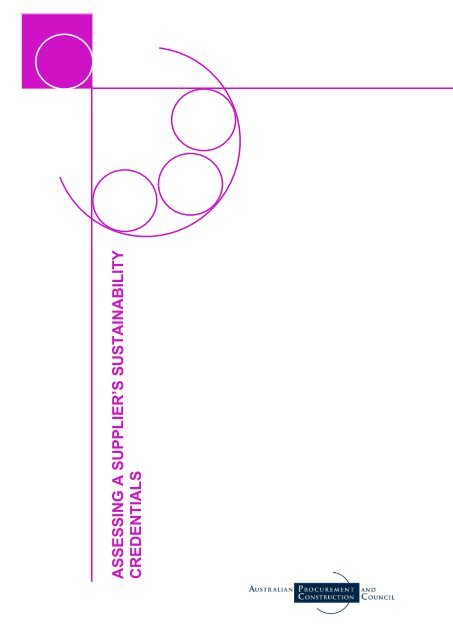
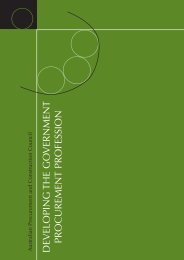
![NATIONAL COST ADJUSTMENT PROVISION EDITION 2 [NCAP2]](https://img.yumpu.com/48266135/1/184x260/national-cost-adjustment-provision-edition-2-ncap2.jpg?quality=85)

